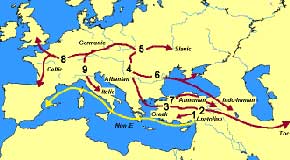Indo-European Languages
Balto-Slavic Family
Vijay John and Jonathan Slocum
The Balto-Slavic languages are spoken mainly in Eastern Europe; they were not attested until late in the first millennium AD. There are two major groups: Baltic, and Slavic. These two are generally agreed to be closely related to one another and, as a whole, they have always been spoken in the same geographic area, ranging from what is now eastern Germany to modern-day Russia. However, Baltic languages have exchanged "popularity" with Slavic languages: Baltic languages were originally spoken over a much wider area than is now the case, and Slavic languages were originally spoken in a much smaller area. Nowadays, the territory occupied by speakers of Slavic languages has expanded considerably, whereas the territory dominated by speakers of Baltic languages has shrunk to a very small region encompassed by the countries of Latvia and Lithuania.
Currently there are only two surviving Baltic languages, Latvian and Lithuanian, both from the East Baltic sub-group; the entire West Baltic sub-group, most notably Prussian, is extinct. But there are many surviving Slavic languages, and these are divided into three sub-groups: West Slavic, East Slavic, and South Slavic. The earliest attested Slavic language, dated to the 9th century AD, is Old Church Slavonic, an extinct Slavic language that has influenced modern Slavic languages to varying degrees as discussed later.
Baltic
The earliest known writings in Baltic languages were quite recent compared to the earliest writings in other Indo-European languages. However, it is known that the Baltic languages were spoken as early as the late Bronze Age from Poland to the Ural Mountains in western Russia. They seem to have been very influential in Eastern Europe, and they were involved in trade with other peoples. For example they interacted with Finnic peoples to the north, who borrowed many words from Baltic languages; these words included agricultural or farming-related terms, kinship terms, and technologies. Although the Baltic languages are now spoken primarily in Latvia and Lithuania, many rivers in Eastern Europe have Baltic names to this day.
The territory occupied by Baltic languages became smaller due to Gothic and Slavic migrations and, later, to invasions by the Teutonic Knights (German crusaders). The Lithuanians controlled a large empire, the Grand Duchy of Lithuania, from 1362 to 1569. The earliest written materials in the Baltic languages appeared only after this empire collapsed, but Baltic languages (especially Lithuanian) preserve a number of early Indo-European characteristics that have been lost in other Indo-European languages. Therefore, although the Baltic languages were attested very late, their conservative nature makes them useful in Indo-European historical linguistics.
West Slavic
The West Slavic languages are divided into three groups: Sorbian, Lechitic, and Czech-Slovak. The Sorbian languages are minority languages spoken in eastern Germany. The Lechitic languages are spoken in and around Poland and include Kashubian (a Pomeranian language, i.e. spoken on the border between Germany and Poland), Silesian (on the border between Poland and the Czech Republic), and Polish, which is the third most widely-spoken Slavic language today (and the most widely-spoken West Slavic language); other Lechitic languages were formerly spoken in Germany but are now extinct. The main Czech-Slovak languages are Czech and Slovak, which did not become distinct languages until the 15th century.
West Slavic languages are those that have been least influenced by Old Church Slavonic; this is because Old Church Slavonic spread from the region of the Southern Slavs, and Hungary separated speakers of Western Slavic languages from that region. In addition, Old Church Slavonic was the liturgical (religious) language of the East Orthodox Church. Since speakers of West Slavic languages were converted to Roman Catholicism rather than to East Orthodox Christianity, Latin was generally used as their liturgical language instead of Old Church Slavonic. The earliest full-length texts in West Slavic languages generally seem to date to the 14th century.
East Slavic
The East Slavic languages include Russian, Ukrainian, Belarusian, and Rusyn (a lesser-known language spoken in many parts of Eastern Europe). Russian is the most widely-spoken Slavic language, and Ukrainian is the second most widely-spoken. However, just as some West Slavic languages are now extinct, not all East Slavic languages have survived. Two examples of extinct East Slavic languages are Russian Church Slavonic and Old East Slavic. Russian Church Slavonic is a modified East Slavic version of Old Church Slavonic that was originally used as a liturgical language, and Old East Slavic is the ancestor of all modern East Slavic languages.
Overall, the East Slavic languages are more closely related than those of any other Slavic group. East Slavic languages were so strongly influenced by Old Church Slavonic that they did not become distinct until the 13th century at the earliest, as literature in East Slavic per se is dated to ca. 1200 in Kiev, which was the capital of the old Russian (or East Slavic) state of Rus' and is now the capital of Ukraine, while there were no large numbers of literary works in distinct East Slavic languages until about 1600.
South Slavic
Modern South Slavic languages can be divided into two groups: Western and Eastern. Western South Slavic languages include Serbo-Croatian (Serbian/Croatian/Bosnian) and Slovenian; Eastern South Slavic languages include Bulgarian and Macedonian (not genetically related to the Greek dialect of Alexander the Great). These languages are mostly spoken in the Balkans, especially in Bulgaria and [what was] Yugoslavia. Unlike Serbo-Croatian and Slovenian, Bulgarian and Macedonian have some linguistic features borrowed from non-Slavic Balkan languages, particularly Greek and Albanian.
Like the East Slavic languages, the South Slavic languages were strongly influenced by Old Church Slavonic. In fact Old Church Slavonic is often considered to be a South Slavic language, though it also seems to be closely related to the Proto-Slavic language from which all Slavic languages descended. The first modern South Slavic language to be written appears to be Slovenian, in the 10th century.
Recommended Reading
• Comrie, Bernard, "Slavonic Languages," pp. 322-328 in The World's Major Languages, ed. by Bernard Comrie. New York: Oxford University Press, 1987.
• Eckert, Rainer, Elvira-Julia Bukeveciute, and Friedhelm Hinze. Die baltischen Sprachen: Eine Einfuehrung. Leipzig, Berlin, Munich: Langenscheidt Verlag Enzyklopaedie, 1994.
• Fortson, Benjamin W., IV. Indo-European Language and Culture: An Introduction. Malden, MA: Blackwell Publishing, 2004.
• Mallory, J.P., and D.Q. Adams. The Oxford Introduction to Proto-Indo-European and the Proto-Indo-European World. Oxford, UK: Oxford University Press, 2006.
• Schmalstieg, William R., "The Baltic Languages," pp. 454-479 in The Indo-European Languages, ed. by Anna Giacalone Ramat and Paolo Ramat. London and New York: Routledge, 1998.




